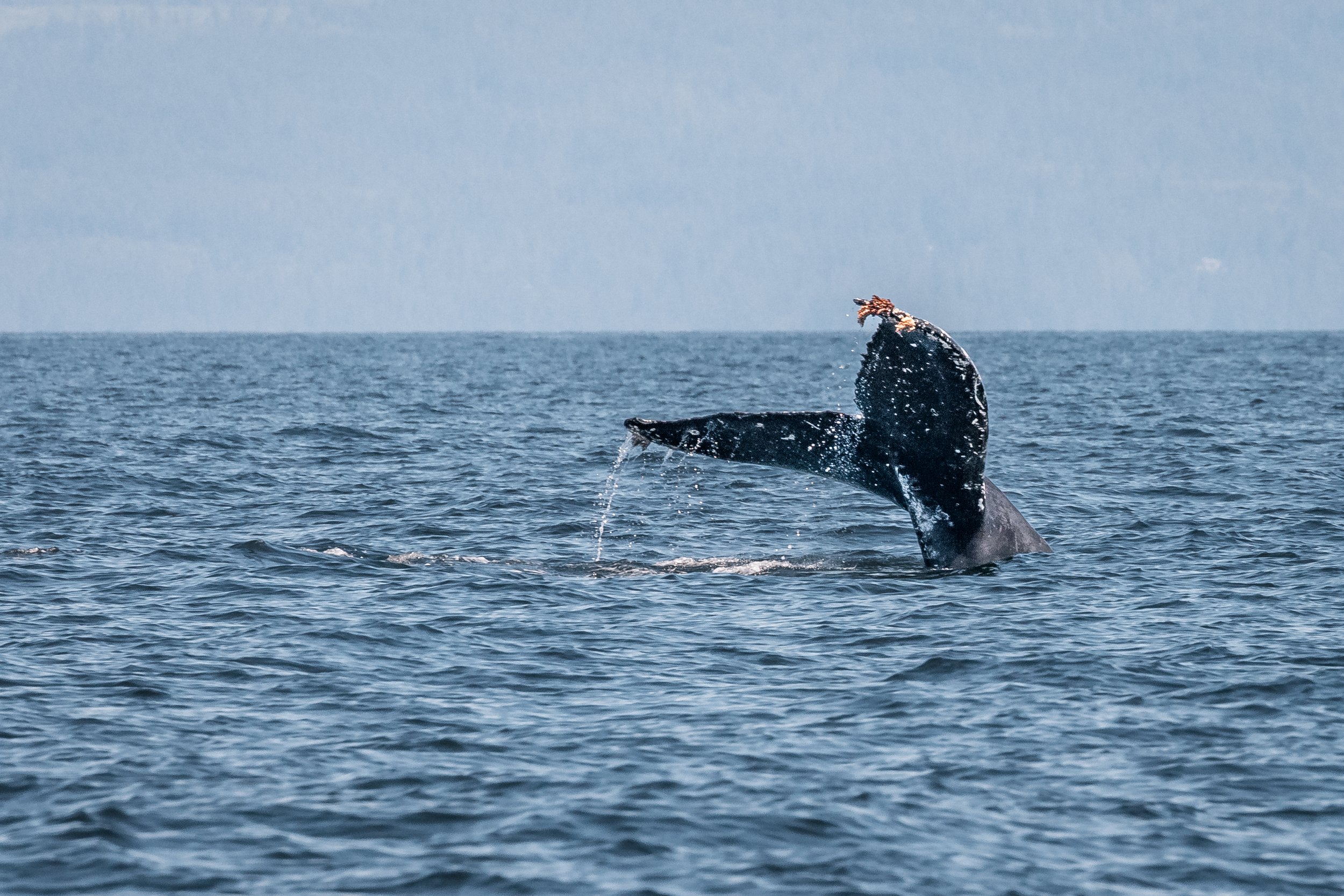June 25th 10:30 AM - Strike and Neowise
We were feeling the summer heat as we climbed onto our boats for the morning tour. Everyone was excited about the clear skies after the weeks of clouds and rain we had experienced. We left the harbour looking for reports of humpbacks near Nanaimo and it wasn’t long before a blow was spotted! We had found our whale, who was very excited about something. Almost immediately after we spotted them one of the whales began chin slapping. Repeatedly lifting his head way out of the water and smacking his chin down on the surface, the sound echoing as the water splashed up around him. Over and over, he continued for nearly 5 minutes. Then he paused, rolled to his side and began lifting his large pectoral fins into the air, slapping them on the surface.
Initially, we thought we had just the one humpback who was causing quite the splash at the surface. After his burst of energy, he went for a dive. Seconds later we saw a blow as the whale surfaced. After they dove again, they were up almost immediately. That’s when we realized we didn’t have one humpback, we had 2! They were taking turns at the surface. Pec slapping and then diving for a feed. After a few surfaces, we got the fluke photos we needed to confirm we were with Strike and Neowise.
Strike is a confirmed female humpback who brought a calf back to the Salish Sea with her just last year. That means this is her break year. She could be enjoying life without a calf right now, or she could already be pregnant with her next calf! Humpbacks typically produce a single calf every 2-4 years. It takes a lot of energy to be a humpback mom. Pregnancies last 11-12 months and require a lot of energy to maintain, then they spend a year raising that calf, showing them the migration route, teaching them how to forage, and providing them with very rich milk. A non-pregnant, non-lactating humpback requires about 3000 lbs of food a day in order to put on enough weight to get them through their migration, but a pregnant or lactating female can consume over 4000 lbs a day just to maintain that pregnancy or provide milk to the calf.
Neowise is the 2020 calf of Heather and was confirmed a male during his first summer in the Salish Sea. He was an active calf who enjoyed breaching, tail lobbing, cartwheeling, and pec slapping, and it looks like he’s kept these habits into his juvenile years.
We’ve noticed an odd trend this year in the return of our humpback whales. It appears they are returning in male + female pairs! Not every whale, but many, have returned in these groups. Zig Zag arrived with friend Split Fin, Divot made it back with Orion, Hydra was hanging out with Nike, and now Strike is here with Neowise. We don’t know what this means, or if it means anything at all. It could just be a coincidence that these whales all returned in the male-female pairs, but it has us interested!
There is still so much we don’t know about humpback social behaviours, and every year they find ways to surprise us. A few years ago we noticed adult females hanging out in groups together, and every female in those groups returned with calves the year after. Last year we had bands of juvenile whales traveling together and those groups seem to be reforming again this year. Now we have several male-female pairs showing up as they return from the breeding grounds. We may never fully understand why these beautiful animals do what they do, but by watching them every year, and collecting this data, we hope to learn a little bit more about the complex social lives they lead.
Enjoy the photos of our wildlife from today’s tour, taken by marine naturalists Rebeka Pirker and Rebecca Stirling.
Photo by Rebeka Pirker
Photo by Rebeka Pirker
Photo by Rebeka Pirker
Photo by Rebeka Pirker
Photo by Rebeka Pirker
Photo by Rebeka Pirker
Photo by Rebeka Pirker
Photo by Rebeka Pirker
Photo by Rebeka Pirker
Photo by Rebeka Pirker
Photo by Rebeka Pirker
Photo by Rebeka Pirker
Photo by Rebeka Pirker
Photo by Rebeka Pirker
Photo by Rebeka Pirker
Photo by Rebeka Pirker
Photo by Rebeka Pirker
Photo by Rebeka Pirker
Photo by Rebeka Pirker
Photo by Rebeka Pirker
A blue heron at the Gabriola Bluffs . Photo by Rebeka Pirker
Photo by Rebecca Stirling
Strike the Humpback. Photo by Rebecca Stirling























